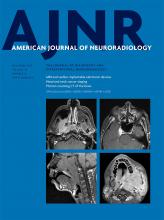Index by author
Fatterpekar, G.M.
- Head and Neck ImagingYou have accessHead and Neck MRI Findings in CHARGE SyndromeM.J. Hoch, S.H. Patel, D. Jethanamest, W. Win, G.M. Fatterpekar, J.T. Roland and M. HagiwaraAmerican Journal of Neuroradiology December 2017, 38 (12) 2357-2363; DOI: https://doi.org/10.3174/ajnr.A5297
Feriozzi, S.
- Adult BrainYou have accessRedefining the Pulvinar Sign in Fabry DiseaseS. Cocozza, C. Russo, A. Pisani, G. Olivo, E. Riccio, A. Cervo, G. Pontillo, S. Feriozzi, M. Veroux, Y. Battaglia, D. Concolino, F. Pieruzzi, R. Mignani, P. Borrelli, M. Imbriaco, A. Brunetti, E. Tedeschi and G. PalmaAmerican Journal of Neuroradiology December 2017, 38 (12) 2264-2269; DOI: https://doi.org/10.3174/ajnr.A5420
Foreman, P.M.
- EDITOR'S CHOICENeurointerventionYou have accessPredictors of Incomplete Occlusion following Pipeline Embolization of Intracranial Aneurysms: Is It Less Effective in Older Patients?N. Adeeb, J.M. Moore, M. Wirtz, C.J. Griessenauer, P.M. Foreman, H. Shallwani, R. Gupta, A.A. Dmytriw, R. Motiei-Langroudi, A. Alturki, M.R. Harrigan, A.H. Siddiqui, E.I. Levy, A.J. Thomas and C.S. OgilvyAmerican Journal of Neuroradiology December 2017, 38 (12) 2295-2300; DOI: https://doi.org/10.3174/ajnr.A5375
This was a retrospective analysis of 465 consecutive aneurysms treated with the Pipeline Embolization Device between 2009 and 2016, at 3 academic institutions in the United States. Cases with angiographic follow-up were selected to evaluate factors predictive of incomplete aneurysm occlusion at last follow-up. Older age (more than 70 years), nonsmoking status, aneurysm location within the posterior communicating artery or posterior circulation, greater aneurysm maximal diameter (>21 mm), and shorter follow-up time (<12 months) were significantly associated with incomplete aneurysm occlusion at last angiographic follow-up.
Foster, C.
- Head and Neck ImagingYou have accessOptimization of Quantitative Dynamic Postgadolinium MRI Technique Using Normalized Ratios for the Evaluation of Temporomandibular Joint Synovitis in Patients with Juvenile Idiopathic ArthritisP. Caruso, K. Buch, S. Rincon, R. Hakimelahi, Z.S. Peacock, C.M. Resnick, C. Foster, L. Guidoboni, T. Donahue, R. Macdonald, H. Rothermel, H.D. Curtin and L.B. KabanAmerican Journal of Neuroradiology December 2017, 38 (12) 2344-2350; DOI: https://doi.org/10.3174/ajnr.A5424
Fujiwara, S.
- EDITOR'S CHOICEExtracranial VascularOpen AccessPreoperative Cerebral Oxygen Extraction Fraction Imaging Generated from 7T MR Quantitative Susceptibility Mapping Predicts Development of Cerebral Hyperperfusion following Carotid EndarterectomyJ.-i. Nomura, I. Uwano, M. Sasaki, K. Kudo, F. Yamashita, K. Ito, S. Fujiwara, M. Kobayashi and K. OgasawaraAmerican Journal of Neuroradiology December 2017, 38 (12) 2327-2333; DOI: https://doi.org/10.3174/ajnr.A5390
Seventy-seven patients with unilateral internal carotid artery stenosis underwent preoperative 3DT2*-weighted imaging using a multiple dipole-inversion algorithm with a 7T MR scanner. Quantitative susceptibility mapping images wereobtained, and oxygen extraction fraction maps were generated. Quantitative brain perfusion single-photon emission CT was alsoperformed before and immediately after carotid endarterectomy. Ten patients (13%) showed post–carotid endarterectomy hyperperfusion. Multivariate analysis showed that a high quantitative susceptibility mapping–oxygen extraction fraction ratio was significantly associated with the development of post–carotid endarterectomy hyperperfusion.
Fulton, Z.
- Pediatric NeuroimagingOpen AccessBasion–Cartilaginous Dens Interval: An Imaging Parameter for Craniovertebral Junction Assessment in ChildrenA.K. Singh, Z. Fulton, R. Tiwari, X. Zhang, L. Lu, W.B. Altmeyer and B. TantiwongkosiAmerican Journal of Neuroradiology December 2017, 38 (12) 2380-2384; DOI: https://doi.org/10.3174/ajnr.A5400








